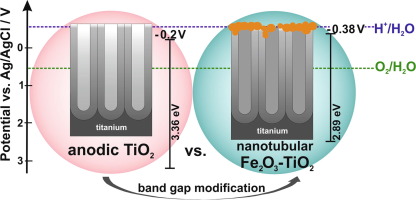当前位置:
X-MOL 学术
›
Appl. Surf. Sci.
›
论文详情
Our official English website, www.x-mol.net, welcomes your
feedback! (Note: you will need to create a separate account there.)
Band gap engineering of nanotubular Fe2O3-TiO2 photoanodes by wet impregnation
Applied Surface Science ( IF 6.3 ) Pub Date : 2020-07-01 , DOI: 10.1016/j.apsusc.2020.146195 Monika Sołtys-Mróz , Karolina Syrek , Joanna Pierzchała , Ewelina Wiercigroch , Kamilla Malek , Grzegorz D. Sulka
Applied Surface Science ( IF 6.3 ) Pub Date : 2020-07-01 , DOI: 10.1016/j.apsusc.2020.146195 Monika Sołtys-Mróz , Karolina Syrek , Joanna Pierzchała , Ewelina Wiercigroch , Kamilla Malek , Grzegorz D. Sulka

|
Abstract Due to many limitations of titanium oxide, its direct use in photoelectrochemical water splitting under solar radiation is ineffective. Band gap engineering based on introduction of the Fe2O3 phase into TiO2 by wet impregnation has been proposed. In particular, nanoporous anodic titanium oxide layers were soaked in solutions with different concentrations of iron ion (5–100 mM) followed by their air annealing at 400 °C. As-prepared nanotubular Fe2O3-TiO2 materials were characterized by using field emission scanning electron microscopy (FE-SEM), energy dispersive spectroscopy (EDS), Raman spectroscopy, X-ray diffraction (XRD), reflectance measurements, Mott-Schottky analysis, and photoelectrochemical tests. It was found that increasing the iron content in anodic materials strongly affects their resulting semiconducting and photoelectrochemical properties. The maximum of generated photocurrent shifts towards visible light as the band gap energy decreases (from 3.36 to 2.89 eV) with the respect to increasing the iron content in the anodic materials.
中文翻译:

湿法浸渍纳米管状 Fe2O3-TiO2 光阳极的带隙工程
摘要 由于二氧化钛的诸多局限性,将其直接用于太阳辐射下的光电化学分解水是无效的。已经提出了基于通过湿浸渍将 Fe2O3 相引入 TiO2 的带隙工程。特别是,将纳米多孔阳极氧化钛层浸泡在不同浓度铁离子(5-100 mM)的溶液中,然后在 400°C 下进行空气退火。通过使用场发射扫描电子显微镜 (FE-SEM)、能量色散光谱 (EDS)、拉曼光谱、X 射线衍射 (XRD)、反射率测量、莫特-肖特基分析和光电化学测试。发现增加阳极材料中的铁含量会强烈影响其产生的半导体和光电化学性能。随着阳极材料中铁含量的增加,带隙能量降低(从 3.36 到 2.89 eV),产生的光电流的最大值向可见光移动。
更新日期:2020-07-01
中文翻译:

湿法浸渍纳米管状 Fe2O3-TiO2 光阳极的带隙工程
摘要 由于二氧化钛的诸多局限性,将其直接用于太阳辐射下的光电化学分解水是无效的。已经提出了基于通过湿浸渍将 Fe2O3 相引入 TiO2 的带隙工程。特别是,将纳米多孔阳极氧化钛层浸泡在不同浓度铁离子(5-100 mM)的溶液中,然后在 400°C 下进行空气退火。通过使用场发射扫描电子显微镜 (FE-SEM)、能量色散光谱 (EDS)、拉曼光谱、X 射线衍射 (XRD)、反射率测量、莫特-肖特基分析和光电化学测试。发现增加阳极材料中的铁含量会强烈影响其产生的半导体和光电化学性能。随着阳极材料中铁含量的增加,带隙能量降低(从 3.36 到 2.89 eV),产生的光电流的最大值向可见光移动。











































 京公网安备 11010802027423号
京公网安备 11010802027423号